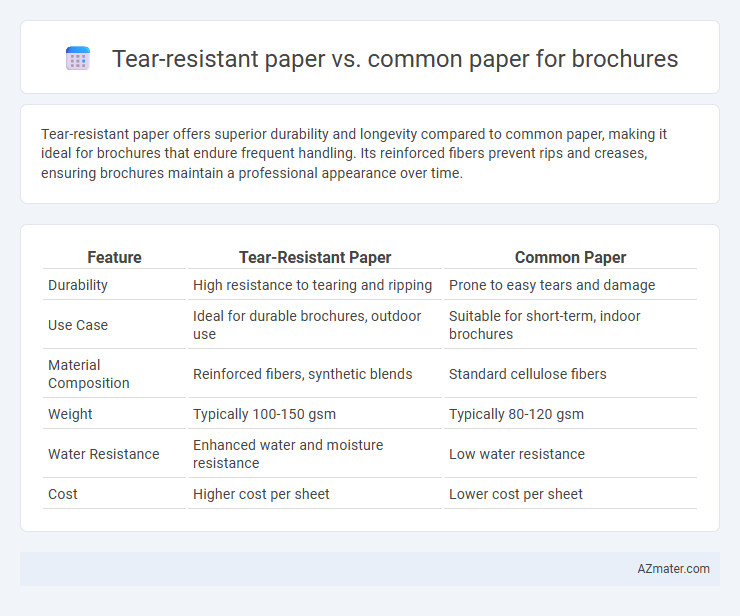Tear-resistant paper offers superior durability and longevity compared to common paper, making it ideal for brochures that endure frequent handling. Its reinforced fibers prevent rips and creases, ensuring brochures maintain a professional appearance over time.
Table of Comparison
| Feature | Tear-Resistant Paper | Common Paper |
|---|---|---|
| Durability | High resistance to tearing and ripping | Prone to easy tears and damage |
| Use Case | Ideal for durable brochures, outdoor use | Suitable for short-term, indoor brochures |
| Material Composition | Reinforced fibers, synthetic blends | Standard cellulose fibers |
| Weight | Typically 100-150 gsm | Typically 80-120 gsm |
| Water Resistance | Enhanced water and moisture resistance | Low water resistance |
| Cost | Higher cost per sheet | Lower cost per sheet |
Introduction to Tear-Resistant Paper vs Common Paper
Tear-resistant paper is engineered with high-strength fibers and advanced coatings to enhance durability, making it ideal for brochures that require longevity and repeated handling. Common paper, typically composed of standard cellulose fibers, lacks these reinforcements, resulting in lower resistance to tears and wear. Choosing tear-resistant paper ensures brochures maintain their structural integrity and professional appearance in demanding environments.
Physical Durability: Tear-Resistant vs Standard Sheets
Tear-resistant paper offers significantly higher physical durability compared to common paper, making it ideal for brochures that require long-lasting use and resistance to wear and tear. Its reinforced fibers and specialized coatings prevent ripping during frequent handling, ensuring that printed materials maintain their integrity over time. Common paper, by contrast, is more prone to creasing and tearing, reducing the lifespan and professional appearance of brochures subjected to regular use.
Visual Appeal and Print Quality Comparison
Tear-resistant paper offers superior durability compared to common paper, ensuring brochures maintain a fresh, professional appearance without frayed edges or damage from handling. The smooth, coated surface of tear-resistant paper enhances print quality by delivering sharper images and more vibrant colors, elevating overall visual appeal. Common paper often absorbs ink unevenly, resulting in duller prints and a less polished look, which can undermine brand perception.
Cost Analysis: Tear-Resistant Paper vs Regular Paper
Tear-resistant paper generally incurs higher upfront costs compared to common paper due to its specialized materials and manufacturing process, but it offers superior durability that reduces replacement and damage expenses in the long run. Common paper is more cost-effective initially but may lead to increased costs over time because of its susceptibility to tearing, especially in frequently handled brochures. Evaluating total expenditure must include both the initial purchase price and potential savings from reduced damage and extended lifespan when choosing between tear-resistant and regular paper for brochures.
Water and Weather Resistance Factors
Tear-resistant paper used in brochures offers superior durability against water and weather compared to common paper, ensuring longer-lasting quality in outdoor or humid environments. Its synthetic fibers and special coatings repel moisture, preventing ink smudging, warping, and deterioration even after exposure to rain or humidity. Common paper lacks these protective features, making it prone to tearing, wrinkling, and color fading when exposed to water and adverse weather conditions.
Environmental Impact and Sustainability
Tear-resistant paper for brochures typically has a lower environmental impact due to its durability, reducing the need for frequent reprints and waste compared to common paper. Common paper often requires more resources over time because it is less durable and prone to damage, leading to increased consumption and landfill contributions. Utilizing tear-resistant paper supports sustainability efforts by promoting longer-lasting materials and reducing overall paper waste.
Handling and Folding Capabilities
Tear-resistant paper offers superior durability and resilience during handling, minimizing the risk of rips or damage compared to common paper. Its enhanced tensile strength allows for multiple folds without compromising structural integrity, making it ideal for intricate brochure designs. Common paper, on the other hand, tends to weaken and crease easily with repeated folding, reducing the overall lifespan and professional appearance of brochures.
Suitable Applications for Tear-Resistant Brochures
Tear-resistant paper is ideal for brochures exposed to frequent handling, harsh environments, or extended use, such as outdoor event flyers, travel guides, and product catalogs. Its durable composition ensures longevity and resistance to wear, making it perfect for industries like tourism, hospitality, and retail where brochures must maintain quality and readability over time. Common paper brochures, while cost-effective for short-term distribution, lack the resilience needed for these demanding applications.
Longevity and Maintenance of Brochure Materials
Tear-resistant paper significantly enhances the longevity of brochures by withstanding frequent handling, folding, and environmental wear better than common paper, which is prone to tearing and damage over time. Brochures printed on tear-resistant paper require less maintenance, reducing the need for frequent replacements and preserving print quality and visual appeal. This durable material is ideal for high-traffic distribution points, ensuring sustained brand presentation and cost-effectiveness in long-term marketing campaigns.
Choosing the Right Paper for Your Brochure Needs
Tear-resistant paper offers superior durability compared to common paper, making it ideal for brochures that require long-lasting quality and frequent handling. Its enhanced strength resists rips and tears, preserving the brochure's professional appearance while maintaining vibrant print clarity. Choosing tear-resistant paper ensures your marketing materials withstand wear and tear, providing better value for outdoor events or high-traffic distribution areas.

Infographic: Tear-resistant paper vs Common paper for Brochure
 azmater.com
azmater.com